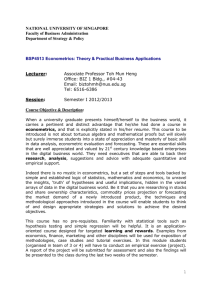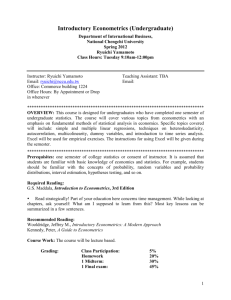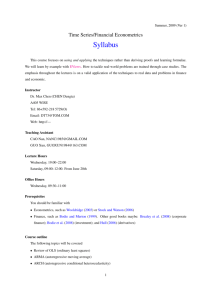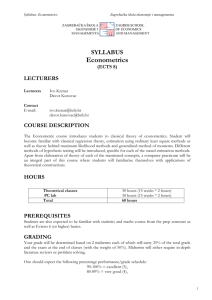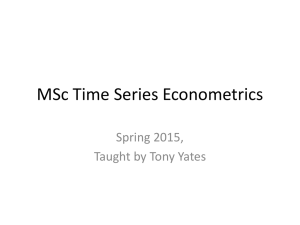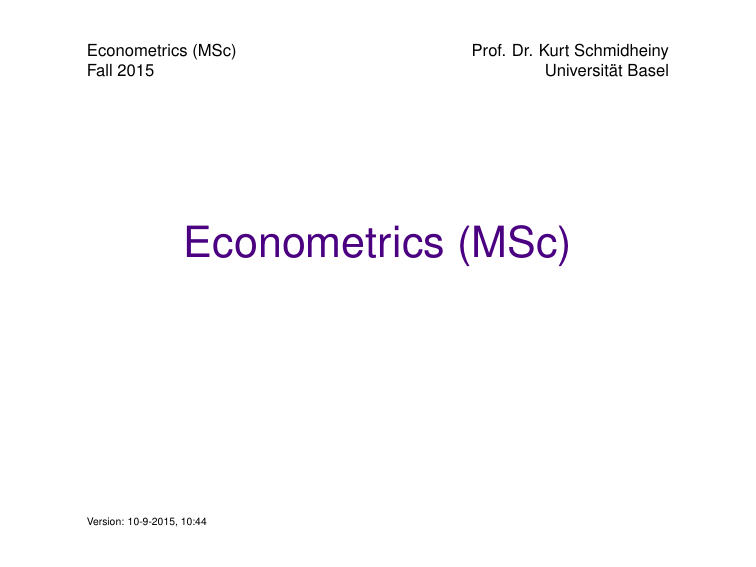
Econometrics (MSc)
Fall 2015
Prof. Dr. Kurt Schmidheiny
Universität Basel
Econometrics (MSc)
Version: 10-9-2015, 10:44
Econometrics: Introduction
Your Teacher
Prof. Dr. Kurt Schmidheiny
Universität Basel
Peter Merian-Weg 6, Office 5.55
kurt.schmidheiny(at)unibas.ch
Office Hours: Tuesday afternoon by appointment per email
Teaching Assistant:
Anja Roth
Universität Basel
Peter Merian-Weg 6, Office 5.49
anja.roth(at)unibas.ch
2
Econometrics: Introduction
3
Class Schedue
Lecture:
Mon 10:15 - 12:00 (Kollegienhaus, Hörsaal 102)
Wed 10:15 - 12:00 (Chemie, Organische, Grosser Hörsaal OC)
Exercise sessions:
During lecture time. Will be announced as we go ahead.
Econometrics: Introduction
4
Course Homepage and Contact
There is a course homepage with slides, handouts and
additional readings:
http://www.schmidheiny.name/teaching/unibas/econometrics/
(username: unibas; password:
)
Stata Questions:
contact Anja Roth <anja.roth(ät)unibas.ch>
R Questions:
contact me <kurt.schmidheiny(ät)unibas.ch>
General Questions:
contact me <kurt.schmidheiny(ät)unibas.ch>
Econometrics: About this course
About this course
Most widely used econometric tools:
OLS, IV, 2SLS, FE, RE, Probit
• What is it?
• How are they used?
• When can they be used?
• When can they not be used?
• What can go wrong?
5
Econometrics: About this course
Challenge of this course: Heterogeneity
This is a very large class with students from very different
backgrounds and with very different goals.
6
Econometrics: About this course
Heterogenous Backgrounds
Some of you ...
... have taken several courses in econometrics
... have only taken basic statistical courses
... very much like mathematics
... very much like getting results
... have performed sophisticated own empirical projects
... have never (really) run a regression
7
Econometrics: About this course
Heterogenous Goals
Some of you ...
... want to do empirical research in their PhD
... want to a purely theoretical PhD
... want to use quantitative analysis in their work,
e.g. consultants, traders, financial analysts
... want to become deciders
→ Some disappointment is inevitable.
⇒ I want to challenge all of you in some dimension.
⇒ You will be able to (partly) choose the formal level.
8
Econometrics: About this course
Outline
1. Causal effects and the logic of randomized experiments
2. Linear regression:
Estimation, small and large sample properties, hypothesis
testing, omitted variable bias, model selection, functional
form
3. Robust inference in the linear model:
heteroscedasticity and clustering
4. Instrumental variable estimation:
Estimation, identification, weak instruments
5. Panel data: Fixed effects, random effects
6. Binary choice: probit and logit
9
Econometrics: About this course
Outline
+ Data generating process and Monte Carlo
+ Sampling distribution and asymptotic proporties
+ Maximum likelihood estimation
10
Econometrics: About this course
11
Companion Course
Fundamentals of Econometric Theory
Fall 2015, Tuesday, 08:15-10:00, by Prof. Schmidheiny
1. Elements of matrix algebra: basic operations, trace, rank,
inverse, eigenvalue and spectral decomposition
2. Elements of probability theory: random variables, joint,
conditional and marginal distribution, expected value and
other moments, change of variables
3. Elements of statistics: point estimation, interval estimation,
hypothesis testing, large sample theory
Econometrics: About this course
12
Companion Course (cont.)
4. The algebra of the multivariate linear regression: degrees
of freedom, Gauss-Markov theorem, Frisch-Waugh-Lovell
theorem
5. The algebra of instrumental variable estimation
6. The algebra of basic panel data methods: within and
between transformation, testing for unrelated effects under
non-spherical disturbances
7. Maximum Likelihood Estimation
8. Binary choice as an example of deriving estimators and
their properties using maximum likelihood
Econometrics: About this course
Parallel and upcoming empirical courses
• Microeconometrics II
Fall 2015, by Prof. Schmidheiny
• Microeconometrics I
Spring 2016, by Prof. Kleiber
• Time Series Analysis I
Fall 2015, by Prof. Kleiber
• Time Series Analysis II
Fall 2015, by Prof. Kleiber
• Advanced Labour Economics
Spring 2016, by Prof. Wunsch
• Seminar Quantitative Methods
Fall 2015, by Prof. Kleiber
13
Econometrics: About this course
14
This course deals (mainly) with observational data
This course deals with Data which is non-experimental, i.e. not
from experiments
• Data from surveys, public records, accounting, ...
• Traditional approach of econometrics
• Prevailing in empirical literature
• Widely used in current research
But experiments become more and more important.
Econometrics: About this course
15
Level of the course
The level of this course is between introductory and advanced
textbooks.
It is introductory concerning ...
• ... most of its topics
• ... its mathematical rigor (limited use of matrices)
It is advanced concerning ...
• ... some of its topics
• ... its mathematical rigor (we do some proofs)
• ... the applications
Econometrics: About this course
Level of the course (cont.)
“Econometrics”
+ “Fundamentals of Econometric Theory”
= “Advanced Econometrics”
16
Econometrics: About this course
17
Prerequisites
I assume that you took a introductory course in
statistics/econometrics.
In particular, you need to know basics of probability
• discrete and continuous random variables
• probability density function, cumulative distribution function
• expected value, E(.), variance, V(.), covariance
• rules about them
⇒ Read Stock/Watson, section 2.1-2.4
Econometrics: About this course
And basics of statistics
• estimation of mean
• standard error, confidence intervals
• hypothesis testing, t-test, p-value
⇒ Read Stock/Watson, section 3.6-3.7
18
Econometrics: About this course
Introductory textbooks
I
Stock, James H. and Mark W. Watson (2012)
Introduction to Econometrics, 3rd ed.
Pearson Addison-Wesley
I
Wooldridge, Jeffrey M. (2009)
Introductory Econometrics: A Modern Approach, 4th ed.
Cengage Learning
I
Wooldridge, Jeffrey M. (2014)
Introduction to Econometrics, 5th ed.
Cengage Learning EMEA
(Identical content as 2009 but no appendices)
19
Econometrics: About this course
Advanced textbooks
I
Cameron, A. Colin and Pravin K. Trivedi (2005)
Microeconometrics: Methods and Applications
Cambridge University Press
I
Wooldridge, Jeffrey M. (2002)
Econometric Analysis of Cross Section and Panel Data
MIT Press
20
Econometrics: About this course
Companion textbooks
I
Angrist, Joshua D. and Jörn-Steffen Pischke (2009)
Mostly Harmless Econometrics: An Empiricist’s
Companion
Princeton University Press
I
Kennedy, Peter (2008)
A Guide to Econometrics, 6th ed.
Blackwell Publishing
21
Econometrics: About this course
Handouts
There are handouts for all topics of the course.
These handouts are ...
... very brief
... not self-contained
... intended to be a useful companion for your life after this
course
⇒ You will absolutely need to work with one or more
textbooks
... most handouts will come in two versions:
with use of matrices and without
.
22
Econometrics: About this course
23
Matrices or NO matrices?
How should you choose the formal level of this course?
• You can pass the exam with or without matrices. You may
not reach to maximum number of points. But almost.
⇒ Choose your level based on your background and/or
ambition
• Only choose matrices if you feel comfortable with them.
Spend your time on the econometrics and not on the
mathematics.
• Choose
matrix-free if you just want to pass this exam.
• Choose matrices if you want to continue with Time Series
Analysis I/II or Microeconometrics I/II.
Econometrics: About this course
24
Statistical Software
• I will use STATA
• Handouts provide STATA and R code
• I assume you are familiar with some statistical software
(There was an introduction to STATA on Sep 13)
Alternative:
• Use another statistical package.
• Please check with me if it covers all methods we use: For
example, R yes, EViews yes, SPSS no
Econometrics: About this course
Problem Sets
There will be 8 problem sets.
• They will not be graded
• You don’t have to hand them in
• They will be discussed in special lectures by Anja Roth
during the usual time slots.
Note:
• It is in your own interest (and responsibility) to do the
problem sets seriously
• The problem sets are key for your understanding
• They are very important for the exam
• Doing the problem sets in groups can considerably
increase their value added
25
Econometrics: About this course
Exam
There will be a final exam in January
• Part with Multiple Choice questions
• Part with open question based on output from statistical
software
• No part with proofs.
26

